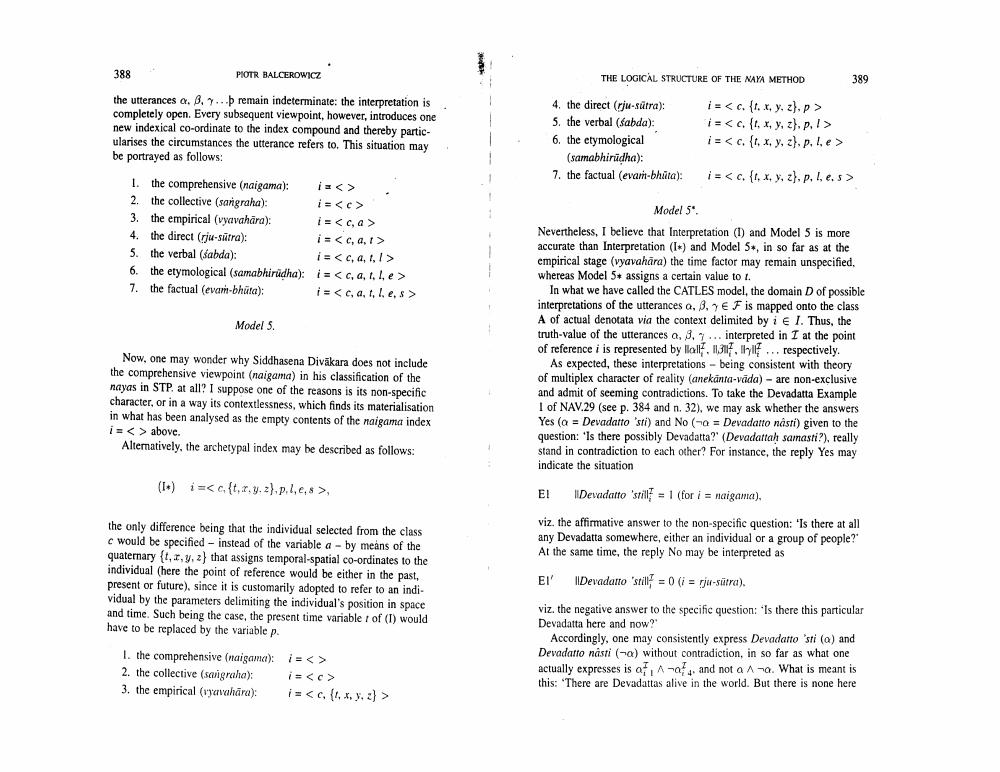Book Title: Logical Structure Of Naya Method Of Jainas Author(s): Piotr Balcerowicz Publisher: Piotr Balcerowicz View full book textPage 6
________________ 388 PIOTR BALCEROWICZ THE LOGICAL STRUCTURE OF THE NAYA METHOD 389 the utterances a. 8.7... remain indeterminate the interpretation is completely open. Every subsequent viewpoint, however, introduces one new indexical co-ordinate to the index compound and thereby particularises the circumstances the utterance refers to. This situation may be portrayed as follows: 4. the direct (rju-sutra): 5. the verbal (sabda): 6. the etymological (samabhirudha): 7. the factual (evan-bhūta): i = < c. {t. x, y, z), p > i =< c. {1, x, y, z). p. 1> i = < c. {1, x, y, z), p. Le > = <c{t, x, y, z), p. 1. e. 5 > 1. the comprehensive (naigama): (najema: = < > . 2. the collective (sangraha): is <C> 3. the empirical (vyavahāra): i = <ca> 4. the direct (rju-sūtra): i = <ca, 1 > 5. the verbal (sabda): i = <0,0,1,1 > 6. the etymological (samabhirudha): i= <ca,1,1,e> 7. the factual (evar bhuta): i =<C, a, i, les > Model 5. Model 5 Nevertheless, I believe that interpretation (1) and Model 5 is more accurate than Interpretation (I.) and Model 5., in so far as at the empirical stage (vyavahara) the time factor may remain unspecified. whereas Model 5. assigns a certain value to L. In what we have called the CATLES model, the domain D of possible interpretations of the utterances a, 8.7 € F is mapped onto the class A of actual denotata via the context delimited by i E I. Thus, the truth-value of the utterances a, 3.7... interpreted in I at the point of reference i is represented by lol. 1307, th ... respectively. As expected, these interpretations - being consistent with theory of multiplex character of reality (anekānta-väida) - are non-exclusive and admit of seeming contradictions. To take the Devadatta Example I of NAV.29 (see p. 384 and n. 32). we may ask whether the answers Yes (a = Devadatto 'sti) and No (-0 = Devadatto násti) given to the question: "Is there possibly Devadatta?' (Devadattah samasti?), really stand in contradiction to each other? For instance, the reply Yes may indicate the situation Now, one may wonder why Siddhasena Divākara does not include the comprehensive viewpoint (naigama) in his classification of the nayas in STP. at all? I suppose one of the reasons is its non-specific character, or in a way its contextlessness, which finds its materialisation in what has been analysed as the empty contents of the maigama index i=< > above. Alternatively, the archetypal index may be described as follows: (1) i=<c{t... y. 2).p.1.> El Devadatto 'still = 1 (for i = naigama), viz. the affirmative answer to the non-specific question: 'Is there at all any Devadatta somewhere, either an individual or a group of people?' At the same time, the reply No may be interpreted as El Devadatto 'still = 0 (i = rju-sutra). the only difference being that the individual selected from the class c would be specified - instead of the variable a - by means of the quaternary (1,7,, 2) that assigns temporal-spatial co-ordinates to the individual (here the point of reference would be either in the past, present or future), since it is customarily adopted to refer to an individual by the parameters delimiting the individual's position in space and time. Such being the case, the present time variable / of (1) would have to be replaced by the variable p. 1. the comprehensive (naigama) i = < > 2. the collective (sangraha): i=<C> 3. the empirical (yawahara); i = <c {1,. y. 2) > viz. the negative answer to the specific question: 'Is there this particular Devadatta here and now?' Accordingly, one may consistently express Devadatto 'sti (a) and Devadatto násti (-a) without contradiction, in so far as what one actually expresses is a. 1 0 . and not a 1-0. What is meant is this: 'There are Devadattas alive in the world. But there is none herePage Navigation
1 ... 4 5 6 7 8 9 10 11 12 13
